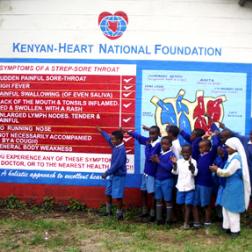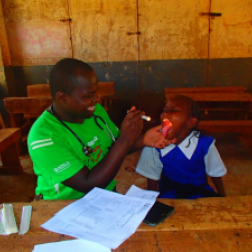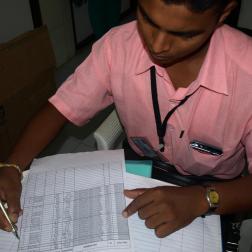Background
New Caledonia has had a rheumatic heart disease control program in place since 2007. The program is facilitated by public health division of the Agence Sanitaire et Sociale de La Nouvelle Caledonie (ASS-NC). The role of the ASS-NC is to provide multi-sectorial coordination and technical and financial support. The annual program cost is estimated at US$470,000 (funded through tobacco and alcohol taxes).
Prevalence of RHD in children
Public health echocardiography screening and research projects have screened thousands of children in New Caledonia. Published data show that of 12,728 children screened between 2008-2010, 114 had RHD giving a prevalence of 8.9 cases per 1000 (CI 95% 7.3-10.6). Prevalence was higher on the main island outside Greater Noumea at 13.7 per 1000 (CI 95% 9.8-17.5) and the outlying island groups- 14.6 per 1000 (CI 8.4-20.9). RHD was seen to be more prevalent in Melanesian children 13.5 per 1000 (CI 95% 10.9-16.1) compared to European children- 1.8 per 1000 (CI 95 % 0.4-3.1).The incidence of RF estimated from hospitalisations data is 42 per 100,000 population aged 5-15years.
All age estimates of ARF/RHD
Data from the ASS-NC provide an overall prevalence estimate of 7.7 per 1000 population, with high rates seen in the Iles des Pins reporting 14 per 1000, and the North of Grand Terre reporting 15 per 1000, compared to the South of Grand Terre (greater Noumea) reporting 5 per 1000.
Cost of disease
The annual health costs of RF/RHD including overseas surgery and hospitalisation is estimated at US$15 million. Many Pacific countries do not have access to cardiac surgery, and where this exists survival rates are often suboptimal. Loss of productivity and premature death from RHD exact the largest proportion of the financial burden on Pacific countries.9 Screening program costs are estimated at US$4,600 per RHD case detected and US$2,300 per cardiac anomaly (congenital heart disease and RHD combined).
RHD control program
The focus of control program strategies are:
- Diagnosis and treatment of RF through case identification, treatment prescription, treatment management, patient and family counseling and case notification.
- Strengthening secondary prevention activities.
- Increasing health professionals’ knowledge of RF/ RHD.
- Early detection of RF/RHD through enhanced surveillance.
- Prevention of recurrences and improved follow-up of cases through the RHD registry. This is based mainly on prophylaxis monitoring, active surveillance and annual echocardiography follow-up.
Primary prevention
Treatment of sore throats is undertaken equally by public and private sectors, including general practitioners, due to the geographical and population distribution of the population.
RHD register
The register is supported through the ASS-NC with public health funding; it is supported by dedicated public health professionals and an RHD nurse. Data are received from both the private and public health sectors. The RHD register is a web-based system which was remodelled in 2012-13, with the introduction on direct data entry commencing in late 2013. The data quality from the public sector are of a high level.
Adherence to prophylaxis
A recent project to evaluate rates of adherence in people receiving antibiotic prophylaxis by intramuscular injections of penicillin and to determine the factors associated with a poor adherence in the population was completed on the island of Lifou. This project included 70 people living with RHD who were receiving injections of antibiotic prophylaxis to prevent ARF recurrence. The study showed that 46% of patients receiving antibiotic prophylaxis for ARF or RHD had a rate of adherence <80% and were therefore at high risk of recurrence of ARF. Three independent factors were protective against poor adherence:
- A household with more than five people (odds ratio, 0.25; 95% confidence interval [CI], 0.08 to 0.75).
- A previous medical history of symptomatic RF (odds ratio, 0.20; 95% CI, 0.04 to 0.98).
- An adequate healthcare coverage (odds ratio, 0.21; 95% CI 0.06 to 0.72).
The authors recommend three strategies to improve adherence:
- Identifying patients receiving antibiotic prophylaxis without medical history of RF to strengthen their therapeutic education.
- Improving the medical coverage in patients with RF or RHD.
- Encouraging the nurse designated for the RF prevention program in Lifou to coordinate an active recall system based on an updated local register.
Screening for RHD
RHD screening as a public health initiative through ASS-NC has been undertaken annually since 2008 for pupils in the 4th grade at primary school (9-10 year olds are targeted). The screening relies jointly on public health professionals and private cardiologists, with final diagnoses mainly confirmed by private cardiologists supported by public funding. Approximately 4,500 primary school aged pupils are screened by echocardiography each year in New Caledonia. Echocardiography screening is undertaken by a cardiologist using a portable echocardiography machine. Since 2012 the ASS-NC has used the WHF RHD echocardiography criteria for diagnosis. In 2013 a trial was undertaken with 1,200 participants using supervised nurses and ultra- portable ultrasound technology (hand held devices).
Education, training and health promotion activities
The ASS-NC provide downloadable technical resources through their website, including a Practical manual with reference protocols for ARF/RHD (Manuel practique: Protocols de reference Rheumatisme Articulare Aigu). This manual and other education material for health professionals, patients and families are available here.
Two RHD workshops for the French Pacific were facilitated by ASS-NC in 2009 and 2011. These workshops brought together health professionals from the three French Pacific countries and Australia to share information and expertise and to strengthen collaboration on ARF/RHD for the French Pacific.






